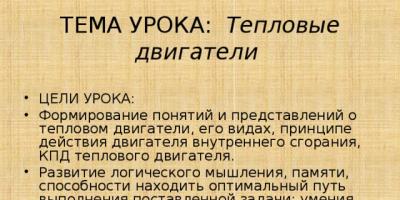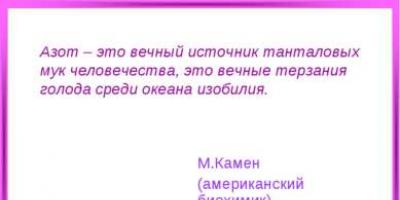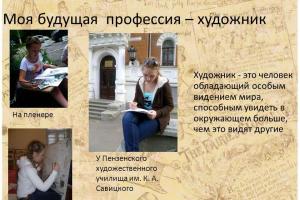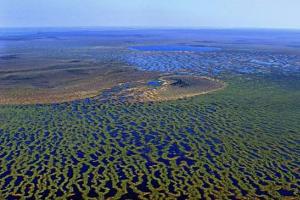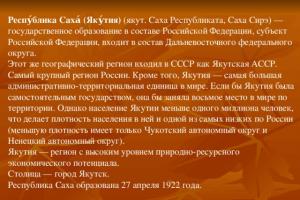Slide 1
The letters are given: R, Z, I, O, A, P, T, M. These letters contain the name of an element about which it is known: - 78% of air consists of a simple substance formed by this chemical element; - the hydrogen compound of this element helps to bring a person out of fainting; - ancient manuscripts are stored in the atmosphere of this gas; - the acid formed by this element dissolves silver, but does not dissolve iron and aluminum; - this acid forms salts that are beneficial to plants, but harmful to people; - if the Russian names of chemical elements are arranged in alphabetical order, then the first one will be...Slide 2
 Nitrogen is the eternal source of tantalum torment of humanity, it is the eternal torment of hunger in the midst of an ocean of abundance. M. Kamen (American biochemist).
Nitrogen is the eternal source of tantalum torment of humanity, it is the eternal torment of hunger in the midst of an ocean of abundance. M. Kamen (American biochemist).
Slide 3

Slide 4
 According to the UN, one third of the world's population is hungry, and every minute several people die from this cause. What is the importance of nitrogen for the existence of life on Earth? Why is nitrogen associated with problems of food shortage and hunger? How can nitrogen solve this problem?
According to the UN, one third of the world's population is hungry, and every minute several people die from this cause. What is the importance of nitrogen for the existence of life on Earth? Why is nitrogen associated with problems of food shortage and hunger? How can nitrogen solve this problem?
Slide 5
 Sub-problems. History of the discovery of nitrogen. Prove the high reactivity of the element nitrogen. What physical properties are characteristic of the simple substance nitrogen? What reactions does molecular nitrogen enter into and what properties does it exhibit in them? What properties of nitrogen are its applications based on?
Sub-problems. History of the discovery of nitrogen. Prove the high reactivity of the element nitrogen. What physical properties are characteristic of the simple substance nitrogen? What reactions does molecular nitrogen enter into and what properties does it exhibit in them? What properties of nitrogen are its applications based on?
Slide 6
 Give definitions of concepts. Atmosphere. Covalent chemical bond. Molecular crystal lattice. Oxidation-reduction reaction. Oxidizing agent, reducing agent.
Give definitions of concepts. Atmosphere. Covalent chemical bond. Molecular crystal lattice. Oxidation-reduction reaction. Oxidizing agent, reducing agent.
Slide 7
 Project assignments. When, by whom and how was the element nitrogen discovered? How common is the element in nature? What explains the discrepancy between its name and symbol? What is the importance of nitrogen for the existence of life on earth? Why is the literal translation “lifeless”? What do you know about the element nitrogen? Give its general characteristics. Write the electronic formula and electronic diagram of the structure of the nitrogen atom. Determine the characteristic oxidation states. Why is the chemical element nitrogen highly reactive?
Project assignments. When, by whom and how was the element nitrogen discovered? How common is the element in nature? What explains the discrepancy between its name and symbol? What is the importance of nitrogen for the existence of life on earth? Why is the literal translation “lifeless”? What do you know about the element nitrogen? Give its general characteristics. Write the electronic formula and electronic diagram of the structure of the nitrogen atom. Determine the characteristic oxidation states. Why is the chemical element nitrogen highly reactive?
Slide 8
 Project assignments. What physical properties are characteristic of the simple substance nitrogen? Draw a diagram of the structure of a nitrogen molecule. What is the mechanism of formation and the nature of the chemical bond in the nitrogen molecule? Why is the nitrogen molecule inert? What reactions does molecular nitrogen enter into and what properties does it exhibit in them? Give examples of reactions that characterize the chemical properties of nitrogen. Why, despite the high nitrogen content in the air, does life on our planet not stop?
Project assignments. What physical properties are characteristic of the simple substance nitrogen? Draw a diagram of the structure of a nitrogen molecule. What is the mechanism of formation and the nature of the chemical bond in the nitrogen molecule? Why is the nitrogen molecule inert? What reactions does molecular nitrogen enter into and what properties does it exhibit in them? Give examples of reactions that characterize the chemical properties of nitrogen. Why, despite the high nitrogen content in the air, does life on our planet not stop?
Slide 9
 Project assignments. How is nitrogen obtained in industry? What properties of nitrogen are its applications based on? What is the essence of the cycle of the element nitrogen in nature? Why is nitrogen called the element of war in some cases, and the element of life and peace in others?
Project assignments. How is nitrogen obtained in industry? What properties of nitrogen are its applications based on? What is the essence of the cycle of the element nitrogen in nature? Why is nitrogen called the element of war in some cases, and the element of life and peace in others?
Slide 10
 Nominations. "The most scientific." "The most ineresting". "The most original." "Most Illustrated"
Nominations. "The most scientific." "The most ineresting". "The most original." "Most Illustrated"
Application of nitrogen
Pure nitrogen is used in various production processes, including ammonia synthesis and the production of nitrogen fertilizers, methane conversion, and associated gas processing.
Nitrogen is used to protect ferrous and non-ferrous metals during annealing. It finds applications in the processes of neutral hardening, stress relief annealing, carburizing, cyanidation, brazing, powder metal sintering, and die cooling. Metallurgy
The use of nitrogen when treating paper, cardboard and even wood objects with ultraviolet or cathode rays to polymerize the varnish coating allows for reduced photoinitiator costs, reduced VOC emissions, improved processing quality, etc. Pulp and paper industry
In the food industry, nitrogen is registered as a food additive E941, as a gaseous medium for packaging and storage, a refrigerant, and liquid nitrogen is used when bottling oils and non-carbonated drinks to create excess pressure and an inert environment in soft containers Food industry
Nitrogen is used in oil and gas production to maintain in-situ pressure and increase product production. This inert gas is widely used to create an inert cushion to ensure explosion and fire safety in process tanks, as well as during loading and unloading operations. Nitrogen is used to maintain a certain pressure in oil and gas tanks, to clean process tanks on gas carriers and LNG and LNG storage facilities, and to purge pipelines. Oil and gas industry
Nitrogen is used to protect tanks, to store raw materials and product, to transport chemical products and to package pharmaceuticals. Pharmaceuticals
Preventing oxidation in semiconductor and electrical circuit manufacturing, purging and cleaning are the main applications of nitrogen in the electronics industry. Electronics
Nitrogen is used in this industry to cool the electrodes of arc furnaces. In addition, it is used to protect against oxidation during production and reduce air temperature. Glass industry
Liquid nitrogen is widely used as a refrigerant; it is used in medicine, especially in cosmetology. Medicine
Nitrogen is the most popular gas for ensuring explosion and fire safety in various industries: from food to nuclear. Being an inert gas, nitrogen allows, when supplied to a technological volume, to displace oxygen and avoid an oxidation reaction. Firefighting
Application. Liquid nitrogen is used as a refrigerant and for cryotherapy. Industrial applications of nitrogen gas are due to its inert properties. Gaseous nitrogen is fire- and explosion-proof, prevents oxidation and rotting. In petrochemistry, nitrogen is used to purge tanks and pipelines, check the operation of pipelines under pressure, and increase the production of fields. In mining, nitrogen can be used to create an explosion-proof environment in mines and to expand rock layers. In electronics manufacturing, nitrogen is used to purge areas that do not allow the presence of oxidizing oxygen. In a process traditionally carried out using air, if oxidation or decay are negative factors, nitrogen can successfully replace air. An important area of application of nitrogen is its use for the further synthesis of a wide variety of compounds containing nitrogen, such as ammonia, nitrogen fertilizers, explosives, dyes, etc. Large quantities of nitrogen are used in coke production (“dry quenching of coke”) during unloading coke from coke oven batteries, as well as for “pressing” fuel in rockets from tanks to pumps or engines. In the food industry, nitrogen is registered as a food additive E941, as a gaseous medium for packaging and storage, a refrigerant, and liquid nitrogen is used when bottling oils and non-carbonated drinks to create excess pressure and an inert environment in soft containers. Content.
Slide 25 from the presentation “Nitrogen and its compounds” for chemistry lessons on the topic “Nitrogen”Dimensions: 960 x 720 pixels, format: jpg. To download a free slide for use in a chemistry lesson, right-click on the image and click “Save Image As...”. You can download the entire presentation “Nitrogen and its compounds.ppt” in a zip archive of 1294 KB in size.
Download presentationNitrogen
“Nitrogen oxide” - 4. Give examples of reactions that prove the acidic properties of nitric oxide (III). Nitric oxide (V). Several nitrogen oxides are known. +1 +2 +3 +4 +5. NO. N2O. All nitrogen oxides, except N2O, are toxic substances. Nitrogen is capable of exhibiting several oxidation states from -3 to +5. +3 +5 2NO2 + H2O = HNO2 + HNO3.
“Silicon and its compounds” - Characteristics plan: In nature, it occurs in the form of oxides, silicates and aluminosilicates. From top to bottom: Garnet. Study the properties of silicon. Analysis of lunar soil samples showed the presence of SiO2 in an amount of more than 40%. Lesson objectives: Application of silicon compounds. Give a general description of the element silicon. It is also found in plants and animals.
“Nitrogen Lesson” - At the end of the lesson, students evaluate their activities in accordance with self-assessment criteria. 2. Operational and execution stage (15 min.). Methodological recommendations for studying the topic “Nitrogen as a simple substance.” 3. Reflective-evaluative stage (20 min.). Equipment and teaching material. It takes 2 hours to study the topic.
“Nitrogen and its compounds” - Nitrogen compounds. Radioactive isotopes of nitrogen with mass numbers 11, 12, 13, 16 and 17 are known. The oxidation states of nitrogen in compounds are?3,?2,?1, +1, +2, +3, +4, +5. The amount of CuO is 2 times greater than calculated. There is another version. Municipal educational institution “Secondary school No. 6 with in-depth study of the French language.”
“Obtaining radioactive isotopes” - Radioactive isotopes in biology. The “labeled atoms” method has become one of the most effective. Radioactive isotopes are widely used in science, medicine and technology. Application of radioactive isotopes. Radioactive isotopes in archeology. Using nuclear reactions, isotopes of all chemical elements can be obtained.
To use presentation previews, create a Google account and log in to it: https://accounts.google.com
Slide captions:
Daniel Rutherford The Story of a Discovery Joseph Priestley Lavoisier, Antoine Laurent Henry Cavendish
7)) +82)))))) +51))))) +33)))) +15))) 5e- 5e- 5e- 5e- 5e-
N2 molecular formula N N electronic formula structural formula
nitrogen - a simple substance, V, C, Z, M N2 Boil = - 195 C Melt = - 210 C 0 0
obtaining in a laboratory in industry
N2 Liquid nitrogen in medicine Ammonia synthesis Fertilizer production Nitric acid synthesis Creation of an inert environment
Test A1. The sum of protons, neutrons, electrons in an atom 14 N 1) 7 2) 14 3) 28 4) 21 A2. Chemical elements are arranged in increasing order of their atomic radii 1) N, C, B 3) N, O, F 2) N, P, As 4) B, Si, N 4) 21 2) N, P, As
A3. Chemical bond in a nitrogen molecule 1) ionic 2) polar covalent 3) nonpolar covalent 4) hydrogen A4. The highest degree of nitrogen oxidation in the compound 1) HNO 3 2) NO 2 3) NO 4) HNO 2
A5. The sum of the coefficients in the reaction equation between nitrogen and hydrogen is 1) 2 2) 3 4) 5 4) 6 A6. The decomposition reaction includes 1) N 2 + 3H 2 = 2NH 3 2) N 2 + O 2 = 2NO 3) 6Li + N 2 = 2Li 3 N 4) NH 4 NO 2 = N 2 + 2H 2 O 4) 6 4 ) NH 4 NO 2 = N 2 + 2H 2 O
A7. Nitrogen is a reducing agent in the reaction 1) N 2 + 3H 2 = 2NH3 2) N 2 + O 2 = 2NO 3) 6Li + N 2 = 2Li 3 N 4) N 2 + 3Ca = Ca 3 N 2
Full name: Shitikova Svetlana Evgenievna Presentation on the topic: “Nitrogen and its properties.” Subject: chemistry. Position: teacher. Name of educational institution: Municipal educational institution Sosnovskaya secondary school No. 2
Nitrogen. Ammonia. Nitrogen and its oxides. Element nitrogen. Properties of ammonia. Characteristics of nitrogen. Nitrogen and its compounds. Nitrogen subgroup. Carbonyl compounds. Characteristics of the element nitrogen. Preparation of phenol-formaldehyde resin. Oxygen compounds of nitrogen. Basic properties of ammonia. Lesson topic: Ammonia. Fixation of molecular nitrogen. Presentation on the topic: Nitrogen.
Permanent connections. Technology lesson in 7th grade On the topic: Tenon joints. Occupational poisoning with nitrogen oxides. 1C: Alcohol production. Problems of obtaining energy resources from biomass. Kazakhstan: production, export, import of pesticides. Automated module for obtaining technetium-99m.
Legislative basis for organizing education for children with disabilities. Energy-saturated and composite materials – production and application technologies. Obtaining legal protection of a trademark within the framework of national and international registration. Comprehensive program “Attracting, supporting and accompanying talented youth in the process of obtaining an engineering education at PSTU.”
Collection ppt. Pb4 compounds. Agriculture 2nd grade. Background for May 9. Titan in chemistry grade 11. Subgroup of carbon and nitrogen. Nitrogen and phosphorus are elements of life. 4 years together in elementary school. Methods for analyzing toxic substances. On May 9th for primary school 1st grade. In chemistry, phosphorus and its compounds, grade 9. Filling out a notice to receive a parcel.
On the organization of general education in the form of family education and self-education in the Krasnodar Territory in the 2013-2014 academic year.

